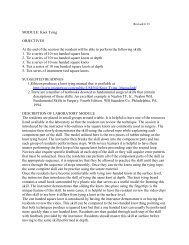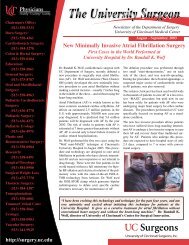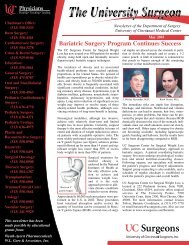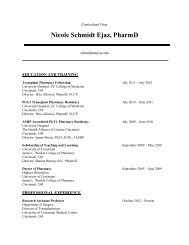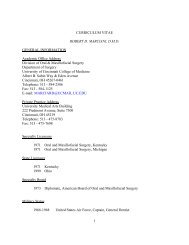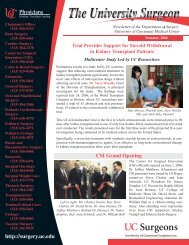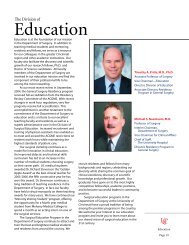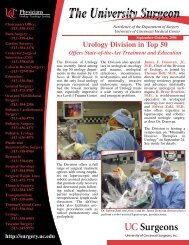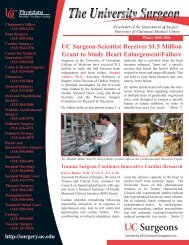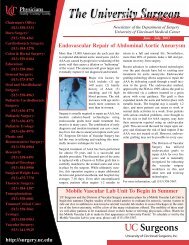Perforated Gastric Ulcers - Surgery - University of Cincinnati
Perforated Gastric Ulcers - Surgery - University of Cincinnati
Perforated Gastric Ulcers - Surgery - University of Cincinnati
Create successful ePaper yourself
Turn your PDF publications into a flip-book with our unique Google optimized e-Paper software.
<strong>Perforated</strong> <strong>Gastric</strong> <strong>Ulcers</strong><br />
A Plea for Management by Simple Closures<br />
William W. Turner, Jr, MD; William M. Thompson, Jr, MD;<br />
Erwin R. Thal, MD<br />
\s=b\One hundred seven patients with perforated gastric ulcers<br />
were treated by either simple closures (omental patches, 81<br />
or ulcer<br />
patients; primary suture without patches, 13 patients;<br />
excisions with closures, two patients) or primary gastric<br />
resections (11 patients). The latter were performed when<br />
ulcers were too large to be treated by simple closures. The<br />
mortality rate after omental patches or ulcer excisions with<br />
closures was 12%, while that following primary gastric resections<br />
was 45%. Patients who underwent closures with suturing<br />
only had a mortality rate <strong>of</strong> 62%, which was significantly<br />
higher than the mortality rate following patch closures. <strong>Gastric</strong><br />
outlet obstructions developed following 15% <strong>of</strong> simple closures<br />
<strong>of</strong> prepyloric ulcers. Closures <strong>of</strong> perforated gastric<br />
ulcers with omental patches or ulcer excisions can be undertaken<br />
with low mortality and morbidity rates. Primary gastric<br />
resections are reserved for patients with ulcers that are large<br />
or located in the prepyloric area.<br />
(Arch Surg 1988;123:960-964)<br />
The operative treatment <strong>of</strong> acutely perforated peptic<br />
ulcers with either simple closures or "definitive" pri¬<br />
mary gastric resections has been debated for decades. Few<br />
reports have focused on perforated gastric ulcers. In one<br />
<strong>of</strong> the earliest series from which data on patients with<br />
perforated gastric ulcers can be examined, a mortality rate<br />
<strong>of</strong> 20% was reported following simple closures,1 in contrast<br />
to that following primary gastric resections, where no<br />
deaths occurred. Furthermore, 50% <strong>of</strong> the patients who<br />
survived simple closures required subsequent gastric re¬<br />
sections for persistent gastroduodenal symptoms. Unfor¬<br />
tunately, follow-up data on the patients who underwent<br />
resections were not presented. The recommendation that<br />
primary gastric resections be considered more frequently<br />
in the treatment <strong>of</strong> perforated gastric ulcers was echoed in<br />
later studies.2-4<br />
In the only study that attempted to randomize patients<br />
with perforated gastric ulcers to treatment via simple<br />
Accepted for publication Jan 5, 1988.<br />
From the Department <strong>of</strong> <strong>Surgery</strong>, <strong>University</strong> <strong>of</strong> Texas Southwestern<br />
Medical Center, Dallas.<br />
Read before the 95th Annual Meeting <strong>of</strong> the Western Surgical Association,<br />
Dallas, Nov 18, 1987.<br />
Reprints not available.<br />
closures or primary gastric resections, gastroduodenal<br />
symptoms recurred in 53% <strong>of</strong> patients after simple closures<br />
and in 57% <strong>of</strong> patients following resections.5 Unfortunately,<br />
the data concerning operative mortality were not presented<br />
in such a way as to allow comparison <strong>of</strong>the two procedures.<br />
In recent reports from McGee and Sawyers,6·7 postoper¬<br />
ative mortality and complication rates were higher follow¬<br />
ing simple closures (29% and 17%, respectively) than after<br />
primary gastric resections (15% and 5%, respectively).<br />
Only the differences in postoperative complication rates<br />
were significant. These results differ from those reported<br />
in a group <strong>of</strong> elderly patients with perforated gastric<br />
ulcers.8 In this study, 47 patients underwent simple closures<br />
with a 32% mortality rate, and seven patients had gastric<br />
resections with a 43% mortality<br />
Downloaded from<br />
www.archsurg.com at <strong>University</strong> <strong>of</strong> <strong>Cincinnati</strong>, on March 20, 2011<br />
rate (differences not<br />
statistically significant). Postoperative complications oc¬<br />
curred with equal frequencies in the two groups.<br />
The problems in drawing conclusions from the above<br />
studies are the small numbers <strong>of</strong> patients in some studies,<br />
the frequent management <strong>of</strong> patients by simple closures<br />
when they were judged "too ill to undergo resections," and<br />
too little information presented to assess comparability <strong>of</strong><br />
operative groups. The purpose <strong>of</strong> this review was to answer<br />
two questions: (1) what are the postoperative complication<br />
rates <strong>of</strong> selective management <strong>of</strong> perforated gastric ulcers<br />
(ie, simple closures where technically feasible or primary<br />
gastric resections in patients with large ulcers), and (2)<br />
can patients be identified who are likely to develop recur¬<br />
rent gastroduodenal symptoms?<br />
PATIENTS AND METHODS<br />
One hundred seven patients with perforated gastric ulcers<br />
underwent operations in our institution from 1955 to 1987. There<br />
were 76 men and 31 women, ranging in age from 20 to 83 years<br />
(mean ± SD, 49 ± 15 years). Perforations were treated by simple<br />
closures in 96 patients and by primary gastric resections in 11<br />
patients. Simple closures involved omental patches (81 patients),<br />
suture without omental patches (13 patients), and local ulcer<br />
excisions and closures (two patients). One <strong>of</strong> the latter patients<br />
had the perforation closed as a pyloroplasty, accompanied by a<br />
truncal vagotomy. All gastric resections were <strong>of</strong> the Billroth II<br />
variety and were accompanied by truncal vagotomies in five<br />
patients.
A history <strong>of</strong> at least one risk factor for ulcer perforation was<br />
present in 71 <strong>of</strong> the patients:<br />
Risk Factor No. <strong>of</strong> Patients<br />
52<br />
Smoking<br />
Ethanol<br />
Ulcerogenic drugs<br />
39<br />
25<br />
Twenty-nine patients had histories <strong>of</strong> either gastric or duodenal<br />
ulcers, including one patient who had both. Twenty-seven <strong>of</strong> these<br />
patients underwent simple closures, and two patients underwent<br />
gastric resections.<br />
Presenting symptoms in 107 patients with perforated gastric<br />
ulcers were as follows:<br />
Symptom<br />
Abdominal pain<br />
Pneumoperitoneum<br />
Nausea/vomiting<br />
Hypotension<br />
Hematemesis<br />
No. <strong>of</strong> Patients<br />
100<br />
73<br />
58<br />
15<br />
14<br />
Melena 13<br />
Fever 10<br />
Diarrhea 6<br />
Hematochezia 1<br />
Ages, sexes, histories, presenting symptoms, and ethnic back¬<br />
grounds were similar among patients from the various operative<br />
groups. Operative procedures were performed with equal frequen¬<br />
cies during the four decades included in this study. Postoperative<br />
complications, including death, also occurred with equal frequen¬<br />
cies throughout the four decades and among the various ethnic<br />
groups.<br />
Most perforations occurred in the prepyloric area (defined as<br />
that area within 3 cm <strong>of</strong> the pylorus). Ulcer sizes were recorded<br />
in 87 patients. Biopsy was performed in 59% <strong>of</strong> patients, and in<br />
only one instance was a malignant neoplasm identified. Concurrent<br />
pyloric or duodenal ulcers were noted in 19% <strong>of</strong> patients. Ulcer<br />
characteristics in patients with perforated gastric ulcers were as<br />
follows:<br />
Characteristic No. <strong>of</strong> Patients<br />
Ulcer location<br />
Prepyloric 49<br />
Antral 40<br />
Fundic 13<br />
Unknown 5<br />
Anterior 84<br />
Posterior 17<br />
Histological findings<br />
Benign 62<br />
1<br />
Malignant<br />
Not documented 44<br />
Early postoperative complications were defined as those occur¬<br />
ring during hospitalizations or within 30 days following operations.<br />
Follow-up information was available for 71 <strong>of</strong> the 84 surviving<br />
patients, ranging over periods from one week to 36 years (median,<br />
7.25 months; 75th percentile, 5.5 years). Thirty-seven percent <strong>of</strong><br />
the patients were followed up for at least ten months.<br />
Statistical analyses were performed using Fisher's exact and<br />
Student's t tests.<br />
RESULTS<br />
Early postoperative complications, including deaths, oc¬<br />
curred in 40 patients (37%), 34 (35%) <strong>of</strong> whom underwent<br />
simple closures and six (55%) <strong>of</strong> whom had primary gastric<br />
resections (not statistically significant). The incidences <strong>of</strong><br />
early postoperative complications among the various op¬<br />
erative subgroups are listed in Table 1. Suture closures <strong>of</strong><br />
gastric perforations without omental patches led to signif¬<br />
icantly more postoperative complications than did omental<br />
patch closures.<br />
The overall operative mortality rate was 21%, including<br />
18 deaths (19%) in the patients who had simple closures<br />
and five deaths (45%) in the patients who had gastric<br />
resections (P = .056). The postoperative mortality rate was<br />
significantly higher among the patients with suture clo¬<br />
sures <strong>of</strong> perforations without omental patches than among<br />
the patients with patch closures (Table 2). There were<br />
significantly more postoperative deaths (45%) among the<br />
patients who underwent primary gastric resections than<br />
in those who had patch closures (12%). Postoperative<br />
deaths occurred more frequently in women (32%) than in<br />
men (17%) (P = . 073).<br />
Among patients in whom ulcer sizes were recorded,<br />
ulcers ranged from 0.1 to 10 cm (median, 1.0 cm; 75th<br />
percentile, 2.0 cm). Ulcer sizes were significantly larger in<br />
the 11 patients who underwent primary gastric resections<br />
(median, 5.0 cm; 75th percentile, 5.0 cm) than in the 76<br />
patients who underwent simple closures (median, 1.0 cm;<br />
75th percentile, 1.5 cm) (P = .001). <strong>Ulcers</strong> were signifi¬<br />
cantly larger in patients who developed early postoperative<br />
complications (P = .004) and among patients who died<br />
(P
Table 1.—Early Postoperative Complications by<br />
Operative Procedures<br />
No. <strong>of</strong> Patients With<br />
Type <strong>of</strong> Closure No. <strong>of</strong> Patients Complications*<br />
Simple closure<br />
Omental patch 81 24<br />
Suture 13 10<br />
Excision and closure<br />
Primary gastric resection<br />
Total 107 40<br />
mental patch vs suture, = .002; suture vs primary gastric resection,<br />
097.<br />
Table 2.—Postoperative Deaths by Operative Procedures<br />
Type <strong>of</strong> Closure No. <strong>of</strong> Patients (Deaths)*<br />
Simple closure<br />
Omental patch 81 (10)<br />
Suture 13 (8)<br />
Excision and closure 2 (0)<br />
Primary gastric resection 11 (5)<br />
Total 107 (23)<br />
*Omental patch vs suture, P10mo
ventions were significantly different in men and women.<br />
No attempt was made in our series to tailor the operative<br />
procedure based on a history <strong>of</strong> ulcer disease or on the<br />
duration <strong>of</strong> symptoms preceding hospitalization. A history<br />
<strong>of</strong> ulcer disease can be unreliable, and there is a poor<br />
correlation with mortality in patients with perforated<br />
peptic ulcers.1·10 A history <strong>of</strong> ulcer disease was identified<br />
in only 28% <strong>of</strong> our patients, and there was no relationship<br />
to mortality or early postoperative morbidity. Delay in<br />
presentation to the hospital after the acute onset <strong>of</strong><br />
symptoms and delay in operative therapy once patients<br />
were admitted to the hospital were associated with signif¬<br />
icant increases in early postoperative complications, par¬<br />
ticularly death. This relationship has been noted previously<br />
in patients with perforated peptic ulcers.10<br />
1. Donaldson G, Jarrett F: <strong>Perforated</strong> gastroduodenal ulcer disease at<br />
the Massachusetts General Hospital from 1952 to 1970. Am J Surg<br />
1970;120:306-311.<br />
2. Rees J, Thorbjarnarson B: <strong>Perforated</strong> gastric ulcer. Am J Surg<br />
1973;126:93-97.<br />
3. Hahnloser P, Bruttin J, Cavin R, et al: Perforation <strong>of</strong>cancer or stomach<br />
ulcer: A one- or two-stage operation (in French). Helv Chir Acta 1980;47:565\x=req-\<br />
574.<br />
4. Wilson-Macdonald J, Mortensen N, Williamson R: <strong>Perforated</strong> gastric<br />
ulcer. Postgrad Med J 1985;61:217-220.<br />
5. Skarstein A, Hoisaeter P: <strong>Perforated</strong> peptic ulcer: A comparison <strong>of</strong><br />
long term results following partial gastric resection or simple closure. Br J<br />
J. Bradley Aust, MD, San Antonio, Tex: I think the title <strong>of</strong><br />
this report is misleading. The authors claim that it is a plea for<br />
simple closure, and yet the report really suggests that judgment<br />
at the time <strong>of</strong> surgery should play a major role in the way in which<br />
perforated gastric ulcers are treated. I certainly concur with that<br />
approach. The omental patch was devised by Graham because<br />
perforated duodenal ulcers frequently leak because the duodenal<br />
wall is thin and inflamed and holds sutures poorly. It is, therefore,<br />
<strong>of</strong> some surprise to me to find out that in this series gastric suture<br />
has similar limitations since the gastric wall is much thicker and<br />
certainly holds stitches much better than the duodenal wall.<br />
My own philosophy in the treatment <strong>of</strong> gastric ulcers is to "make<br />
the punishment fit the crime," if I can.<br />
Prepyloric ulcers are treated in a manner similar to duodenal<br />
ulcers. If there is little abdominal contamination and the patient<br />
is not late in arriving in the operating room, I believe that<br />
definitive surgery is reasonable, and if the patient is late and<br />
there is much contamination, suture and patching is in order.<br />
For primary gastric ulcers, we all agree that medical treatment<br />
is less effective than for duodenal ulcers. Therefore, resectional<br />
therapy is in order if deemed safe by the lack <strong>of</strong> delay or<br />
contamination.<br />
Giant ulcers mandate gastric resection in spite <strong>of</strong> their greater<br />
risk. Even so, in our own environment, delays and degree <strong>of</strong><br />
contamination lead to far more local excisions <strong>of</strong> the ulcer for<br />
histologie confirmation, suture, and patching than definitive sur¬<br />
gery.<br />
I became interested in what we might have done in the past two<br />
years and looked up our experience with gastric ulcer. We had 17<br />
perforated gastric ulcers. I was amazed to find that seven <strong>of</strong> these<br />
were in infants, leaving only ten adult perforations in two years.<br />
George L. Jordan, Jr, MD, Houston: We are indebted to this<br />
group for a very detailed presentation <strong>of</strong>the problem <strong>of</strong> perforating<br />
gastric ulcers. However, their conclusions are not justified, either<br />
on the basis <strong>of</strong> their own data or review <strong>of</strong> the literature and<br />
certainly not from our experience.<br />
They do suggest a selective approach, and that concept is one<br />
with which I fully agree and we have advocated for years, but<br />
their selection is not very helpful.<br />
If you look at their mortality rates, you will find that their<br />
highest mortality rate is in a group treated by a special technique<br />
<strong>of</strong> primary closure that they do not recommend any more. To<br />
References<br />
Discussion<br />
<strong>Perforated</strong> gastric ulcers are uncommon, and the fund <strong>of</strong><br />
knowledge from which to make judgments about operative<br />
management is still growing. A limited number <strong>of</strong> retro¬<br />
spective studies report conflicting results after various<br />
operative procedures. Experience gained from the treat¬<br />
ment <strong>of</strong> more frequent duodenal ulcer perforations may<br />
not be applicable to the management <strong>of</strong> perforated gastric<br />
ulcers.<br />
The results <strong>of</strong> our study indicate that simple closures <strong>of</strong><br />
perforated gastric ulcers with omental patches or local<br />
excisions with closures can be performed with low mortal¬<br />
ity and low early morbidity rates. Primary gastric resec¬<br />
tions can be reserved for those patients who have large<br />
ulcers. Our data suggest that patients with prepyloric<br />
perforations may benefit from primary gastric resections.<br />
Surg 1976;63:700-703.<br />
6. McGee G, Sawyers J: Primary gastric resection for perforated gastric<br />
ulcer. Surg Rounds 1987;10:19-26.<br />
7. McGee GS, Sawyers JL: <strong>Perforated</strong> gastric ulcers: A plea for management<br />
by primary gastric resection. Arch Surg 1987;122:555-561.<br />
8. St James Collier D, Pain J: <strong>Perforated</strong> gastric ulcer: A reappraisal <strong>of</strong><br />
the role <strong>of</strong> biopsy and oversewing. J R Coll Surg Edinb 1985;30:26-29.<br />
9. Brown R, Langman M, Lambert P: Hospital admissions for peptic<br />
ulcer 1958-1972. Br Med J 1976;1:35-37.<br />
10. Sirinek K, Levine B, Swesinger W, et al: Simple closure <strong>of</strong> perforated<br />
peptic ulcer: Still an effective procedure for patients with delay in treatment.<br />
Arch Surg 1981;116:591-596.<br />
condemn gastric resection as having a high mortality rate when<br />
certain types <strong>of</strong> simple closure also have a high mortality rate does<br />
not make a strong point for the differential approach.<br />
The high mortality rate in both <strong>of</strong> those groups, that is, the<br />
resection group and the closure group, almost surely relates to<br />
selection <strong>of</strong> patients more than it does to the procedure employed,<br />
and it would appear that the omental patch closures were most<br />
likely performed in the patients with smaller ulcers, which as a<br />
rule are most easily treated.<br />
The authors decry the absence <strong>of</strong> data for long-term studies in<br />
resection, but present none. We have a tremendous number <strong>of</strong><br />
long-term data concerning surgery for gastric ulcer with other<br />
complications and there is really no reason to presume that<br />
treatment <strong>of</strong> this complication will produce a different long-term<br />
result.<br />
They present only a short follow-up, and yet, as I understand it,<br />
19 <strong>of</strong> their 63 patients treated by simple closure have already had<br />
trouble, with an average follow-up time <strong>of</strong> only seven months.<br />
With follow-up times <strong>of</strong> four or five years, I predict that you are<br />
going to find up to 75% or 80% recurrence rates.<br />
The literature does not support the concept that gastric resec¬<br />
tion for perforated ulcer in selected patients is associated with a<br />
high mortality rate. This one is high, I am sure, because <strong>of</strong><br />
selection <strong>of</strong> patients, not because <strong>of</strong> the procedure.<br />
Our reported experience with perforated ulcer includes 1183<br />
patients, 244 <strong>of</strong> whom had gastric ulcers. Our most recent (1987)<br />
report was by David Feliciano, MD. He reported an 11-year<br />
experience from the Ben Taub Hospital that I think would correlate<br />
with your patient population; 60 <strong>of</strong> those patients had gastric<br />
ulcers and there were no carcinomas in the group.<br />
We resected 57% <strong>of</strong> these ulcers and closed 43%. The mortality<br />
rate in the resected group was 8.8%, and our overall mortality<br />
rate for all 60 patients for all types <strong>of</strong> perforations <strong>of</strong> gastric ulcer<br />
was only 13.3%. This mortality rate is not significantly different<br />
for our total experience from that <strong>of</strong> the best group reported here<br />
with simple closure.<br />
We have looked specifically at the patients over 60 years <strong>of</strong> age<br />
and reported our experience with those patients in 1984. In that<br />
particular report we had 26 gastric ulcers in patients ranging from<br />
60 to 97 years <strong>of</strong> age. We performed resections in 13 and closed<br />
the ulcers in 13 <strong>of</strong> the patients. In these patients over 60 years <strong>of</strong><br />
age, our mortality rate was 19.2%.<br />
Downloaded from<br />
www.archsurg.com at <strong>University</strong> <strong>of</strong> <strong>Cincinnati</strong>, on March 20, 2011
I have several questions for the authors. First, what was the<br />
actual cause <strong>of</strong> death? Our studies have not indicated that the<br />
procedure is really the cause <strong>of</strong> death. The cause <strong>of</strong> death relates<br />
to other problems in these patients.<br />
Second, I am concerned about drawing conclusions on the basis<br />
<strong>of</strong> a short follow-up period. I am really concerned about this is¬<br />
sue because, according to the report, histologie nature was deter¬<br />
mined in only 63% <strong>of</strong> the ulcers, so I wish you would describe your<br />
follow-up procedure in patients in whom you performed simple<br />
closure.<br />
Third, I am surprised that since you did include one patient<br />
with carcinoma that the incidence was that low. Our incidence <strong>of</strong><br />
carcinoma, which is not included in our data (we break those up<br />
into a separate group), is approximately 5%. There are not many<br />
perforated gastric ulcers per year; therefore, treatment <strong>of</strong> those<br />
patients is done by a multitude <strong>of</strong> surgeons over a long period <strong>of</strong><br />
time, hence the difficulty in recording a large series. Nevertheless,<br />
the data on gastric ulcer are pretty clear relative to long-term<br />
results <strong>of</strong> definitive surgery, which are good, and I think they are<br />
pretty clear relative to the long-term results <strong>of</strong> simple closure,<br />
which are not good.<br />
Robert E. McCurdy, MD, Denver: It is a delight for people<br />
like me who grew up in the era <strong>of</strong> gastric surgery in the late 1940s,<br />
1950s, and 1960s to find out that there is still some pathology<br />
occurring in the stomach.<br />
It has been one <strong>of</strong> the great mysteries to me as to why we have<br />
had this tremendous decline in peptic ulcer disease, and this<br />
happened even before the advent <strong>of</strong> cimetidine.<br />
I tell our residents that I do not know <strong>of</strong> any condition in the<br />
abdomen thatjustifies more good surgicaljudgment than selecting<br />
the operation for a patient with perforated ulcer.<br />
I would like to present<br />
an anecdotal case from our former<br />
president, Tom Throckmorton, MD. He was in the midst <strong>of</strong> a<br />
family vacation in Winter Park, Fla, two years ago when he called<br />
me and said, "My daughter just perforated a gastric ulcer. Would<br />
you send a helicopter up to Winter Park to pick her up?"<br />
Later that day, at surgery, she was found to have a high<br />
perforated gastric ulcer. We performed biopsy, vagotomy, and<br />
pyloroplasty.<br />
I said, "Tom you told me over the phone that she had had a<br />
perforated gastric ulcer. What made you think that it wasn't just<br />
routine duodenal ulcer?"<br />
He looked at me and said just one word: "Experience."<br />
Robert J. Baker, MD, Chicago: I don't think most <strong>of</strong> us would<br />
try to do a Tanner or some other fancy sort <strong>of</strong> gastrectomy in a<br />
patient with a very high lying perforation, and in that circum¬<br />
stance, Dr Turner and his colleagues have certainly shown that a<br />
patch plus some definitive ulcer operation, usually a parietal cell<br />
vagotomy in our center, can remedy a difficult situation.<br />
I would like to add a word <strong>of</strong> caution to what has been said by<br />
the previous speaker concerning gastric cancer. We have had four<br />
telling experiences in the last three years with what were thought<br />
to be perforations <strong>of</strong> benign gastric ulcers. Two <strong>of</strong> these were<br />
resected, and the pathological specimen revealed infiltrating<br />
adenocarcinoma. Unfortunately, the other two patients were so ill<br />
and the perforations so small that the ulcers were patched; when<br />
the patients underwent endoscopy in the postoperative period,<br />
one at about two months' and one at about four months' follow-up,<br />
obvious carcinomas were seen. These patients all underwent<br />
operation by experienced surgeons with a senior surgical resident;<br />
this proves again that it is not always a simple matter to ascertain<br />
at the operating table whether a gastric ulcer is benign or<br />
malignant. I would strongly urge that emphasis be placed on<br />
determination <strong>of</strong> malignancy, as about 12% <strong>of</strong> our perforated<br />
gastric ulcers prove to be malignant. We must always think <strong>of</strong><br />
carcinoma and add that factor to the other data that have already<br />
been presented in support <strong>of</strong> resection. A perforated gastric ulcer<br />
is a condition that usually requires a definitive operation.<br />
I would like to ask a question <strong>of</strong> the authors. When in the<br />
postoperative period did these patients who were treated by patch<br />
undergo endoscopy? The prepyloric ulcers are not a problem, as<br />
those are really duodenal ulcers in behavior and treatment. They<br />
end up feeling like and undergoing a postoperative course like a<br />
perforated duodenal ulcer does. But if one is going to look for<br />
persistent disease or more importantly for carcinoma, an optimal<br />
follow-up is required. If the follow-up is not secured, there is a<br />
potential, or about one chance in eight, that the patient harbors a<br />
carcinoma.<br />
Dr Turner: Dr Aust has pointed out a real problem we face in<br />
our hospital concerning delays both in getting the patients to the<br />
hospital and in getting the complication diagnosed, and subse¬<br />
quently getting the patient into the operating room once in the<br />
hospital. That plagues our series, as pointed out.<br />
He also reiterated the rarity <strong>of</strong> gastric ulcer perforations; that<br />
has been our experience as well. We had only 107 patients over 33<br />
years.<br />
We have all sat at the font <strong>of</strong> knowledge that Dr Jordan<br />
represents, and I was privileged to have him discuss my study.<br />
We do not condemn the high mortality we found for primary<br />
gastric resection in our study. Quite the contrary; these were<br />
highly selected patients with larger ulcers. Larger ulcers tended<br />
to occur in older patients, and it is not surprising at all to us that<br />
the mortality rate in our group with primary gastric resections<br />
was quite high.<br />
The patients who died did so primarily <strong>of</strong> ventilatory failure and<br />
pneumonia and not <strong>of</strong> complications directly related to the ulcer<br />
disease in terms <strong>of</strong> leaks or the like.<br />
The only possible exception was in the patients who had simple<br />
closures, and I would just reiterate that I think the decision to<br />
use simple closures in these patients was bad judgment in the<br />
context <strong>of</strong> our advocacy <strong>of</strong> judgment's importance here. In three<br />
<strong>of</strong> those patients intra-abdominal abscesses developed, which may,<br />
in fact, have been related to leaks at ulcer repair sites.<br />
Much has been said about follow-up <strong>of</strong> these patients, and all I<br />
can say about our patients is that in our county hospital setting,<br />
mea culpa. We advocate close follow-up, particularly endoscopy<br />
within four weeks <strong>of</strong> closures by patch plications. However, many<br />
<strong>of</strong> these patients do not come back for follow-up. It is a justifiable<br />
criticism <strong>of</strong> conservative management.<br />
Dr McCurdy mentioned the importance <strong>of</strong> judgment, and I<br />
would reiterate that we believe this as well. We believe it was bad<br />
judgment to perform simple closures in some patients.<br />
Why the stomach, Dr Aust, does not tolerate simple closure, I<br />
cannot answer other than from my own personal experience. When<br />
you look at these ulcer margins, it does not surprise me that they<br />
do not hold sutures very well.<br />
Dr Baker, your question was very interesting and your comments<br />
about dealing with high gastric perforations are intriguing. It is<br />
precisely that problem that led me to question Dr Sawyers' report<br />
last year at the Western Surgical Association meeting. When I<br />
asked how they treated a high gastroesophageal junction perfo¬<br />
ration, his answer was total gastrectomy. That led us to look at<br />
our experience with patch closures and gastrectomies.<br />
When do we perform endoscopy? As I mentioned, at four weeks.<br />
Incorrect Reference Information. \p=m-\Inthe article entitled "Safe Management <strong>of</strong> the Impossible<br />
Duodenum: Risk Avoidance in <strong>Surgery</strong> <strong>of</strong> Peptic Ulcer," published in the May 1988<br />
Archives (1988;123:558-562), an incorrect publication date appeared in reference 8. The year <strong>of</strong><br />
publication should be 1972, not 1932 as printed.<br />
Downloaded from<br />
www.archsurg.com at <strong>University</strong> <strong>of</strong> <strong>Cincinnati</strong>, on March 20, 2011



